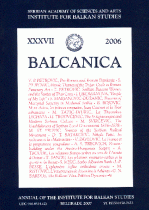Patterns of Martyrial Sanctity in the Royal Ideology of Medieval Serbia: Continuity and Change
Patterns of Martyrial Sanctity in the Royal Ideology of Medieval Serbia: Continuity and Change
Author(s): Smilja Marjanović-DušanićSubject(s): History
Published by: Balkanološki institut - Srpska akademija nauka i umetnosti
Keywords: royal ideology; medieval Serbia; cults; traditions;
Summary/Abstract: Especially important for the development of the holy king concept with the Serbs appears to be the early period of Serbian sovereignty, initially in Zeta, and subsequently in Raška under Stefan Nemanja and his descendants. During the eleventh century, cults of royal martyrs arise across the Slavic world, receiving a most enthusiastic response connected with the spread of the martyrial and monastic ideals in Byzantium. The cult of St Vladimir is the earliest royal saint’s cult with the Serbs, and it is rightfully set apart from the ideologically consistent whole encompassing the subsequent cults of the Nemanjic rulers. The cult of this royal saint undergoes a change in the twelfth century as regards the image of the exemplary ruler. The martyrial cults of holy kings emerge in medieval Serbia only in the fifteenth century, under the influence of completely different motives. The cults of national royal saints associate domestic dynasties with the Old Testament-based traditions of God-chosenness, which play a central role in the processes of securing political legitimation for ruling houses. At the turn of the fourteenth and fifteenth centuries, we can see both the national and universal relics being used for raising an awareness of chosenness, observable in expanding the sacred realm as the fatherland’s prayerful shield. In that sense, all-Christian relics, especially those of Constantinopolitan provenance, become integrated into domestic traditions.
Journal: BALCANICA
- Issue Year: 2006
- Issue No: 37
- Page Range: 69-81
- Page Count: 12
- Language: English

